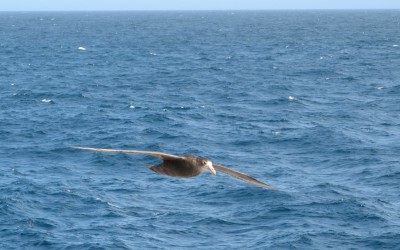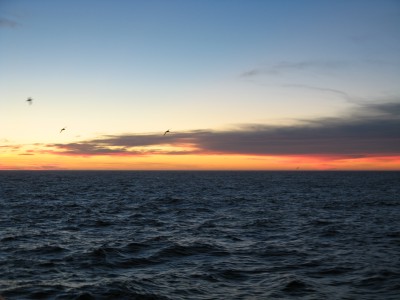

Thursday, December 18, 2008
The intercom came on at 7:30, telling us wake up and that breakfast would be ready at 8am. We had woken up a bit before this anyway. During the night, Crystal thought she had become airborne at one point. Justin thought the rolling back and forth was fun, like a roller coaster. Whether he would think the same thing from here on out would be another matter. It was sunny out on the deck, and it was nice to get some fresh air. There were some birds flying around the boat - msot of them were Giant Petrels. Our best guess was that the boat would startle and/or churn up fish towards the surface, and the birds thought they would be better able to nab some fish that way.
 |
 |
We had breakfast, which was decent, but neither one of us was particularly hungry. After breakfast, Crystal didn't feel so hot (not from the breakfast, but from seasickness) and took a little break in our room. Justin went out on the deck and saw a bunch of people sitting next to their seasickness bags. He tried not to look, not wanting to start feeling sick from watching others be sick. We were told this was "regular" in terms of the swells, so hopefully we'll all get used to it. Justin went down to the bar for a bit to catch up on the diary, and while in the bar there were some very large swells that caused all of the glasses, botles, condiments, etc. to all fall over and make a huge mess. Also, the chairs went sliding around from side to side as the boat tipped from one side to the other. Moving around was an adventure, but we watched the staff members and tried to mimick how they walked. The best way to walk seemed to be by taking smaller steps, never crossing one leg over another. It reminded Justin of how one is supposed to move when playing tennis or basketball - knees bent, feet at shoulder width (preferably under the shoulders). This worked pretty well for us, especially in comparison to other passengers, but the staff were still far far better at it.
 |
 |
We spent the rest of the morning alternating between going out on board and watching the seabirds (petrels, albatrosses, prions) and coming inside to get warm and see if any of our photos turned out. Not surprisingly, since the birds were moving, our ship was moving, and our ship was rolling from side to side, most of the photos were out of focus.
At lunch, we noticed that it was at best half full of people. Apparently, over half of the people had been sick this morning and decided they weren't feeling well enough to eat. Some came to lunch but then left shortly thereafter. Justin, for whatever reason, was in great shape. This was only the second time he had ever been on a cruise (the other one being our Galapagos cruise), but he wasn't even feeling a twinge of seasickness. Perhaps he got he sea legs through osmosis from the books he read recently on Magellan, Drake, Cook and Bligh. All the rolling did was make him sleepy.
 |
 |
The afternoon was more of the same, alternating between outside bird watching and inside sleeping or lounging. Our guides told us later in the day that they had never seen so many birds following the boat at one time. At 3:30, we got a lecture on the Falklands from one of the guides, Lex. This was interesting, since Lex had told us the day before that he had never been to the Falklands. The Falklands are a British Overseas Territory, with over 3000 people (not including soliders) living there. Almost everyone lives in Stanley, with the rest living in "Camp," the name for every place not called Stanley. There are two main islands, West Falkland and East Falkland. Tomorrow we are set to go to Carcass Island and West Point Island, both part of the West Falkland area. The Falklands, unlike South Georgia, is not part of the ridge that South Georgia lies on, the one that curves around from the tip of South America to the Antarctic Peninsula. Instead, they just "fell off" when the supercontinents broke off (so something like Madagascar).
No people were found when the Falklands were discovered, but there was a little bit of evidence that someone had lived there before. It was perhaps the people from Tierra del Fuego. There is a little bit of question as to who first discovered the Falklands. Magellan may have found them (he sailed very closely nearby), but he did not record seeing them, or name them. The first confirmed record is from John Davis of the HMS Desire, in 1592. The first person to set foot on the islands was John Strawn (sp?). After that, people more or less left the islands alone - no one settled there in 1764. Even today, it is extremely sparsely populated.
After Argentina gained its independence, it decided to colonize the area, set up a prison, and get some iindustry started. Shortly thereafter, the British came back, and thus began uncomfortable agreement between the Argentines and the British. In 1982, Argentina "invaded" the Falklands, South Georgia, and the South Sandwich Islands. While the British initially gave in, Britain responded quite strongly (much more than Argentina expected). Britian sent an entire fleet down to take the islands back, sunk one of the Argentina's largest ships, and then Argentina left, never to be heard again. The "war" didn't last very long at all.
Today, the Falkland Island's revenue comes from wool (but not as much as earlier), squid, and tourism. There are no (native) trees on the islands, but a lot of smaller items, including tussock grass, which is quite prolific. 75% of all Rockhopper penguins live on the Falklands. They are distinguishable from the Macaroni penguin because their bill is smaller and their yellow "eyebrows" are separated. Also, 75% of black-browed albatrosses are from the Falklands. 30% of all Gentoo penguins live on the Falklands. 40% of the Southern Giant Petrels nest on the Falklands as well. One of the reasons there are so many birds is because there is an "arm" off of the Southern Ocean, called the Falkland current, that brings cold water up from the Antarctic area. Thus, there are many more fish, squid, etc. Total, there are roughly 60 birds (split between resident land birds, resident water birds, and breeding seabirds) in the Falklands. West Point Island has a bird reserve.
In addition to Rockhoppers (which we hopefully will see), the Falklands also have Magellanic (which are more rare than on South America) and King (which have only one colony in the Falklands). Other things we might see in the Falklands are elephant seals, Commerson's Dolphin (black and white, but marked differently than Orcas), and Peale's Dolphin.
 |
 |
After the class, we watched parts 1 and 2 of Life In The Freezer (it was very good, we may have to buy it when we get home), then it was more of the same. Justin tried in vain to get an "A" picture of one of the flying birds (which was helped a bit when the sun started going down, making everything backlit and less noticeably out of focus), while Crystal slept some and read some. There was a short meeting at 7pm, and then it was dinner time. We met two other people from the US, Peggy and Lindy (one from Montana and one from Illinois) - these were the first two we met from the US. After dinner Lex (one of the guides) chatted us up for a bit about some of the things we were going to see, what other excursions he had been on and would be going on, plus a littany of other topics. All those petrels, all those pictures, it's a pity we didn't get a better one. Hopefully tomorrow we'll have better luck on stationary ground with stationary animals. At about 10pm we called it a night.